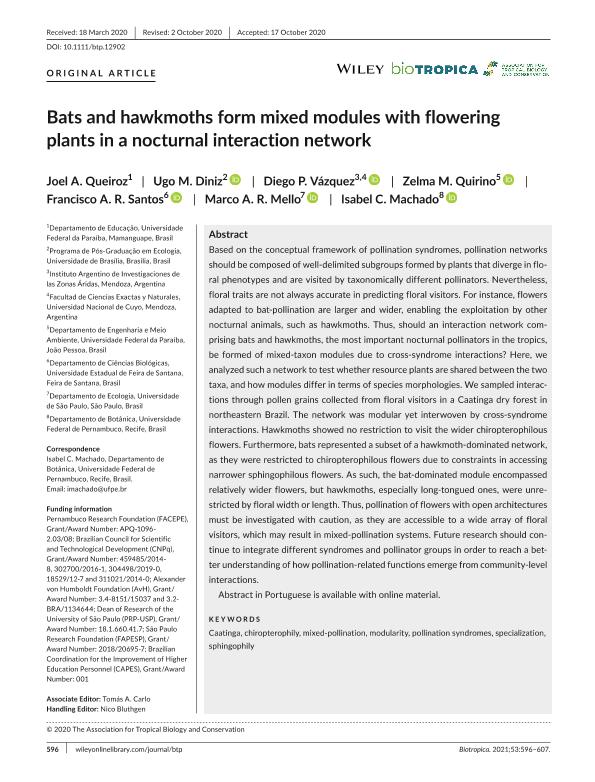Mostrar el registro sencillo del ítem
dc.contributor.author
Queiroz, Joel A.
dc.contributor.author
Diniz, Ugo M.
dc.contributor.author
Vazquez, Diego P.

dc.contributor.author
Quirino, Zelma M.
dc.contributor.author
Santos, Francisco A. R.
dc.contributor.author
Mello, Marco A. R.
dc.contributor.author
Machado, Isabel

dc.date.available
2022-09-12T17:52:46Z
dc.date.issued
2021-03
dc.identifier.citation
Queiroz, Joel A.; Diniz, Ugo M.; Vazquez, Diego P.; Quirino, Zelma M.; Santos, Francisco A. R.; et al.; Bats and hawkmoths form mixed modules with flowering plants in a nocturnal interaction network; Wiley Blackwell Publishing, Inc; Biotropica; 53; 2; 3-2021; 596-607
dc.identifier.issn
0006-3606
dc.identifier.uri
http://hdl.handle.net/11336/168397
dc.description.abstract
Based on the conceptual framework of pollination syndromes, pollination networks should be composed of well-delimited subgroups formed by plants that diverge in floral phenotypes and are visited by taxonomically different pollinators. Nevertheless, floral traits are not always accurate in predicting floral visitors. For instance, flowers adapted to bat-pollination are larger and wider, enabling the exploitation by other nocturnal animals, such as hawkmoths. Thus, should an interaction network comprising bats and hawkmoths, the most important nocturnal pollinators in the tropics, be formed of mixed-taxon modules due to cross-syndrome interactions? Here, we analyzed such a network to test whether resource plants are shared between the two taxa, and how modules differ in terms of species morphologies. We sampled interactions through pollen grains collected from floral visitors in a Caatinga dry forest in northeastern Brazil. The network was modular yet interwoven by cross-syndrome interactions. Hawkmoths showed no restriction to visit the wider chiropterophilous flowers. Furthermore, bats represented a subset of a hawkmoth-dominated network, as they were restricted to chiropterophilous flowers due to constraints in accessing narrower sphingophilous flowers. As such, the bat-dominated module encompassed relatively wider flowers, but hawkmoths, especially long-tongued ones, were unrestricted by floral width or length. Thus, pollination of flowers with open architectures must be investigated with caution, as they are accessible to a wide array of floral visitors, which may result in mixed-pollination systems. Future research should continue to integrate different syndromes and pollinator groups in order to reach a better understanding of how pollination-related functions emerge from community-level interactions. Abstract in Portuguese is available with online material.
dc.format
application/pdf
dc.language.iso
eng
dc.publisher
Wiley Blackwell Publishing, Inc

dc.rights
info:eu-repo/semantics/openAccess
dc.rights.uri
https://creativecommons.org/licenses/by-nc-sa/2.5/ar/
dc.subject
CAATINGA
dc.subject
CHIROPTEROPHILY
dc.subject
MIXED-POLLINATION
dc.subject
MODULARITY
dc.subject
POLLINATION SYNDROMES
dc.subject
SPECIALIZATION
dc.subject
SPHINGOPHILY
dc.subject.classification
Ecología

dc.subject.classification
Ciencias Biológicas

dc.subject.classification
CIENCIAS NATURALES Y EXACTAS

dc.title
Bats and hawkmoths form mixed modules with flowering plants in a nocturnal interaction network
dc.type
info:eu-repo/semantics/article
dc.type
info:ar-repo/semantics/artículo
dc.type
info:eu-repo/semantics/publishedVersion
dc.date.updated
2022-09-01T15:25:45Z
dc.journal.volume
53
dc.journal.number
2
dc.journal.pagination
596-607
dc.journal.pais
Reino Unido

dc.journal.ciudad
Londres
dc.description.fil
Fil: Queiroz, Joel A.. Universidade Estadual da Paraiba; Brasil
dc.description.fil
Fil: Diniz, Ugo M.. Universidade do Brasília; Brasil
dc.description.fil
Fil: Vazquez, Diego P.. Consejo Nacional de Investigaciones Científicas y Técnicas. Centro Científico Tecnológico Conicet - Mendoza. Instituto Argentino de Investigaciones de las Zonas Áridas. Provincia de Mendoza. Instituto Argentino de Investigaciones de las Zonas Áridas. Universidad Nacional de Cuyo. Instituto Argentino de Investigaciones de las Zonas Áridas; Argentina. Universidad Nacional de Cuyo. Facultad de Ciencias Exactas y Naturales; Argentina
dc.description.fil
Fil: Quirino, Zelma M.. Universidade Estadual da Paraiba; Brasil
dc.description.fil
Fil: Santos, Francisco A. R.. Universidade Estadual de Feira de Santana; Brasil
dc.description.fil
Fil: Mello, Marco A. R.. Universidade de Sao Paulo; Brasil
dc.description.fil
Fil: Machado, Isabel. Universidade Federal de Pernambuco; Brasil
dc.journal.title
Biotropica

dc.relation.alternativeid
info:eu-repo/semantics/altIdentifier/doi/http://dx.doi.org/10.1111/btp.12902
dc.relation.alternativeid
info:eu-repo/semantics/altIdentifier/url/https://onlinelibrary.wiley.com/doi/10.1111/btp.12902
Archivos asociados
